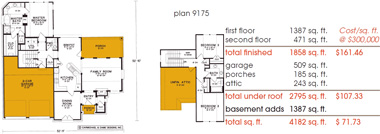Whats Your Cost Per Square Foot
Check Out Your BuilderWe hear horror stories of builders who will quote a price based purely on square feet and then pound the buyer with extras after the job is started. Reputable builders will have a long list of references from happy homeowners. Contact those references! Similarly, A cheaper cost per square foot will be long forgotten when issues with the home arise after you've moved in and your builder ignores your please to fix them—or simply moves out of town! What's the cost per square foot of your new home warranty? Every home builder can give you a detailed and accurate cost per square foot.A "production" builder who builds the same portfolio of plans over and over again, purchases large tracts of land and develops entire neighborhoods, and controls the amount of personalization (such as minimal, if any, plan changes and limited finish selections) can most quickly quote you a price per square foot. There are fixed standards with few variables. Their economies of scale Semi-custom builders offer a wider variety of home designs, building sites and finishes for your home. Such builders will typically modify their home plans to suit your needs, too. They may initially provide a wide price range, such as "$100 to $200 per square foot depending on what you want" reflecting many of the variables addressed. Such a wide range is not very satisfying, but know as you make decisions, the ultimate price per square foot comes clearer into focus. A custom home builder may never build the same home twice. She doesn't have historical data for that specific home to look back on as a starting point. Knowing that custom home buyers often have specific products and amenities in mind, providing a cost per square foot before the plans and details are firmed up can lead to disastrous results. Do you REALLY want the cheapest?Even if you can get fairly comparable cost per square foot info from multiple builders—meaning they're all bidding using the same set of plans, specifications, home site cost factors, product amenities, finishes, etc.—are you going to automatically take the lowest price per square foot? How do you suppose the builder with the lowest price per square foot was able to do it? And, understand you want your builder to make a profit on building your home. If she doesn't, she won't be in business to take care of any warranty issues with your home and you'll be stuck regretting taking the deal that was "too good to pass up." When it comes to the cost per square foot for your new home, like with most of life's major purchases, you get what you pay for. Home building is a craft and an honorable profession to which some exceptional people have devoted their lives. But as with any profession, there are a few bad apples that tarnish the industry. So...if you choose to, use preliminary cost per square foot numbers to help you know if you're "in the ballpark" budget-wise. Don't assume they'll be the basis of your purchase agreement. And exercise great caution when using cost per square foot in comparing builders and their homes. Even if you believe you've got an "apples for apples" comparison, the low cost per square foot builder might just be one of those bad apples! |
For most home builders, asking them, "What's your cost per square foot?" 
Without knowing more, a price is just a shot in the dark. Do you have a bad spark plug wire or does the entire motor need to be rebuilt? Everybody uses it.When a real estate agent lists a house for sale…when a mortgage loan officer submits a loan application for underwriting…when an appraiser values your home…they all report the home's square footage and a price for the home. The entire existing home market uses this square footage price as a barometer They're either being lazy or they don't understand the differences. Is a used Honda Accord worth as much as a brand It's easyEasy to calculate—simply divide the price by the square footage and you've got a concrete number. It's easy to understand (and who isn't looking to simplify a purchase as important as your home?) It's easy to use—as one way to compare homes. And it's easily accessible—the internet and particularly major real estate websites publish this information. Can you afford what you want?Looking at design, amenities and products shown in new homes through the lens of cost per square foot can help you get a feel for whether what you want You want to get a fair deal.Understanding why homes cost what they do is difficult. There are so many variables! Cost per square foot seems like a fair way to ensure you're not getting ripped off, but can be a rip-off tool itself when used in a misleading way by an unscrupulous builder. You're a bargain shopperand are looking for the lowest cost per square foot. This lowest price approach can make sense for standardized, mass-produced products, like big-screen 
|
10 Things you need to know
before comparing new homes by their cost per square foot

Land costs.Did the cost per square foot quoted include the home site? A $25,000 lot represents $12.50 per square foot for a 2,000 square foot home. But if building that same home on a $60,000 lot, the home site equates to $30 per square foot, $17.50 per square foot higher! Even the neighborhood can impact your cost per square foot. If subdivision covenants require a full masonry (brick, stone or stucco) front elevation, the home will cost more than if it were built with vinyl siding on the front. And community amenities such as walking trails, pocket parks, clubhouses, pools, etc., all have a cost which is passed along to each homebuyer in the form of higher prices for the building lot. |
|
|||||||||



















